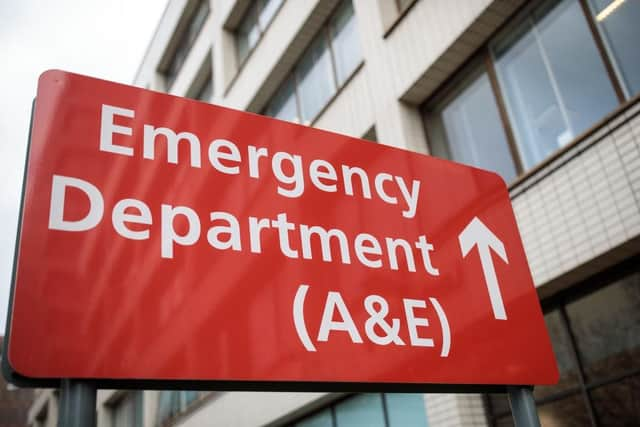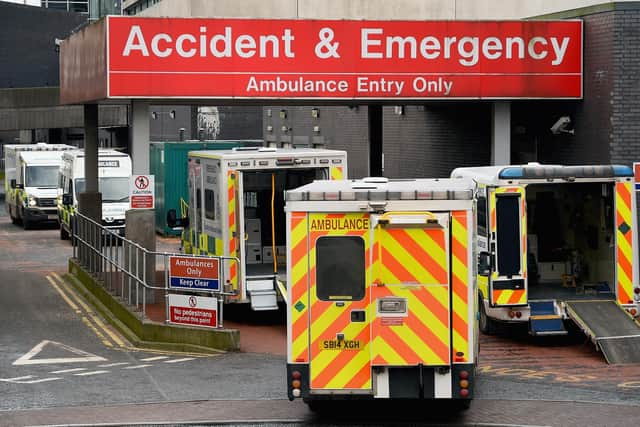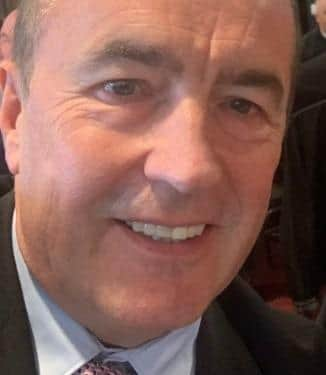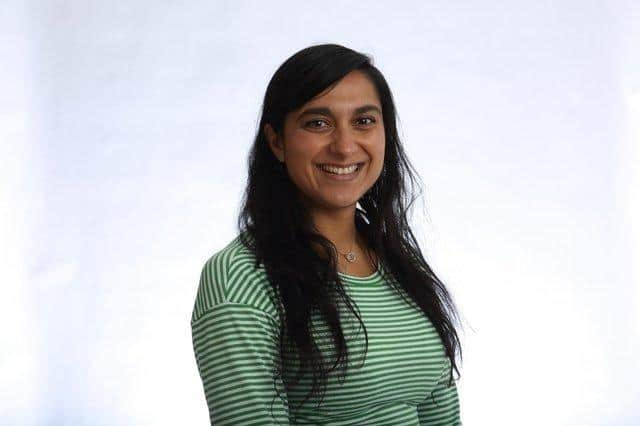Covid Scotland: NHS is ‘falling apart’ doctors say, as patients wait up to four days at A&E
Kat had recently been having migraines and was on new medication, but then experienced visual disturbances - spells of flashing or shimmering light - and almost collapsed.
The GP practice could not give Ms Caballero, 39, an appointment, and told her to call back the next day or take her daughter to Accident and Emergency (A&E).
Advertisement
Hide AdAdvertisement
Hide AdConcerned Kat was having a reaction to the medication and might get worse, she brought her to the Royal Infirmary of Edinburgh.


After a nine-hour wait, her daughter had been given the all-clear. But by that point, Ms Caballero had “lost confidence” in Scotland’s NHS.
Staff were doing their best in a very difficult situation, she said, but the department was clearly “far too busy and under-staffed”.
The waiting room was “completely overrun”, and there was so little space relatives were asked to stand so patients could sit.
Ms Caballero saw a man come in complaining of chest pains, who was told to wait, while a woman was crying because of her abdominal pain.


“There was an older lady who looked absolutely awful, her son was nearly in tears when he brought her in,” Ms Caballero said.
This woman, who Ms Caballero believes was about 70 years old, ended up sitting on her son’s knee due to lack of seats.
“I thought, ‘where is that poor lady’s dignity?’” said Ms Caballero.
Advertisement
Hide AdAdvertisement
Hide AdAnother arrival asked if her daughter could be brought through to another area instead of the waiting room, to reduce the risk of catching Covid as it was extremely busy and her daughter was immunosuppressed.


They were sent to wait outside, Ms Caballero said.
“It was freezing cold… it just felt inhumane.”
The wait faced by Ms Caballero’s daughter is not unusual.


The most recent A&E waiting times recorded by Public Health Scotland (PHS) matched the worst ever, with just 66 per cent of patients admitted, transferred or discharged within the Scottish Government target of four hours.
Some 2,373 people waited over eight hours in just one week, while 944 waited 12 hours.
And figures released to Scotland on Sunday revealed at least one patient waited four days at A&E in the last two months, while 36 people waited more than two days.
“Something needs to be done,” said Dr Lailah Peel, a junior doctor working in A&E and chair of the British Medical Association’s (BMA) Junior Doctors Committee.
There is “no doubt” Scots are coming to harm as a result of long waits in A&E, Dr Peel said.
“You know it’s going to be bad at the moment when you're going into a shift, you just don't quite know how bad, how many beds we are down in the hospital, how long the patients are going to have to wait in the department.”
The crucial problem is “exit block”, a build-up of patients in A&E because there are not enough hospital beds to admit them to. This is caused by a lack of social care capacity, meaning patients who are well enough to be cared for in the community cannot be discharged from hospital.
Advertisement
Hide AdAdvertisement
Hide Ad“We need to be doing more to fix this… we need improved social care so we can get patients out of hospital,” said Dr Peel, adding that it is “far cheaper and safer” for patients to be cared for at home.
The Scottish Government also needs to urgently increase staffing and improve conditions for junior doctors, she added.
“The spotlight is on A&E because that's where the most obvious issue is at the moment,” she said.
“But it's not an A&E problem. Lots of people don't understand that, they think that we're not working hard enough in A&E. But A&E is picking up the slack for the whole system falling apart.”
While exit block is the biggest issue facing A&E, Dr Peel also sees patients attending with non-emergencies, which could have been dealt with elsewhere.
“The whole system is struggling at the moment, and as one of the few services that runs 24 hours, seven days a week, every single day of the year, I think we often become people’s fallback,” she said.
“I think the system could be more joined up and we could all talk to each other better, and that would include giving patients realistic expectations about what does need to go to A&E and what can go to different places.”
Dr David Shackles, a GP in Perth and Joint Chair of the Royal College of GPs’ Scotland Council, also believes some patients are visiting A&E when they could be going to their GP instead.
Advertisement
Hide AdAdvertisement
Hide Ad“We have to support our patients, if it’s an emergency A&E is the right place to go, if it’s not then we need to try and have conversations and take appropriate action at the right timescale,” he said.
“What we don’t want is for the wrong people to go to A&E and reduce the ability for A&E to manage the patients they need to see.”
GPs in Scotland are under immense pressure, he said, with an ever-increasing workload which means some patients are facing delays.
“The problem is there's a finite number of appointments, there’s a finite amount of work we can do,” he said.
Staffing shortages, as well as Covid absence, has led to a reduced workforce, and demand has increased, with patients now coming to GPs about issues which they put off during the pandemic.
The huge backlog in non-urgent NHS care has also led to more work for GPs, as more patients are experiencing pain while waiting for operations, or seeing their condition deteriorate.
Like Dr Peel, Dr Shackles believes the biggest problem is exit block, caused by shortages in social care staff.
“It’s a whole-system thing, there’s not one area where the problem occurs,” he said.
Advertisement
Hide AdAdvertisement
Hide Ad“We’re really struggling to try and keep people out of hospital because we can't access the care packages.
“We get frail, elderly people who might have fallen, who've got other comorbidities or illnesses.
“We'd like to keep them out of hospital, but we can't access high-quality care packages to keep the patient safe in the community.
“We end up having to refer them to hospital because we’re out of options.”
Andy Thomas is one patient who believes he would have been better off seeing a GP, but on advice from a pharmacist and minor injuries unit went to A&E at Glasgow’s Queen Elizabeth University Hospital (QEUH) in early April.
The 59-year-old, who is retired and now volunteers at a foodbank, was stung by an insect and the sting swelled up across his leg.
He was concerned about infection, but didn’t want to “bother” his GP.
He went to a local pharmacy, but the pharmacist sent him to a minor injuries unit. Staff at the minor injuries unit told him to go to A&E.
Advertisement
Hide AdAdvertisement
Hide AdMr Thomas waited eight-and-a-half hours to be seen at the QEUH.
“I could have driven to London in the time it took to see a doctor,” he said.
“It wasn’t a good experience.”
Space was so tight in the waiting area that patients were sitting on the floor and on window ledges, Mr Thomas said.
An elderly woman, who he guessed was around 85 years old, waited as long as he did, with her son, who became “uptight” about the wait.
“There’s a tea and coffee machine, but obviously you need money for that and there weren’t any other catering facilities apart from these machines,” said Mr Thomas, adding that staff did bring the woman a coffee.
Attempting to provide food and drink for patients is a “real nightmare”, said Dr Peel.
A&E departments are not set up to hold patients for long periods of time, she said, and increased waits throw up a range of issues including patients needing food, medication and to contact their families.
There are often no quiet areas for patients to sleep if they are in A&E overnight, which can be “really distressing”.
Advertisement
Hide AdAdvertisement
Hide AdSpending so many hours on a trolley, rather than a hospital bed, can also be difficult, especially for older patients.
Some departments have started offering food services because of longer waits, Dr Peel said.
“But we don't have people on duty in the same way as perhaps they are on the ward,” she said.
"Essentially, we've got a lot more to do because patients are staying longer.”
The five health boards with the highest numbers of patients waiting long periods all offer some form of food and drink, though when asked if this service has increased in recent months, only NHS Lothian and Ayrshire and Arran said it had.
NHS Lothian said patients are often offered sandwiches and drinks, and if they are in the department during mealtimes they can be given a hot meal.
The health board has increased support worker staffing levels in the face of recent demand.
NHS Ayrshire and Arran said catering services supply food as requested, and tea and coffee making facilities are also available.
Advertisement
Hide AdAdvertisement
Hide AdDemand for food and drink in A&E has increased during the pandemic, said director of acute services Joanne Edwards.
NHS Greater Glasgow and Clyde said tea, coffee and biscuits are provided daily to A&E, and staff in the department can order sandwiches or hot meals for patients staying a long time.
At Borders General Hospital support and catering staff provide meals and drinks for patients waiting long periods.
NHS Lanarkshire provides “light refreshments”, but not a catering service.
A spokesperson for the Scottish Government said people should consider whether their condition is an emergency before going to A&E, and if it is not then visit their local GP or pharmacy, or call NHS 24.
A fall in Covid cases, as well as recent changes to infection prevention and control guidance, should reduce pressure, they said.
They added: “Our £1 billion NHS Scotland Recovery Plan sets out plans and ambitions for recovery. This will support an increase in inpatient, daycase and outpatient activity to address the backlogs of care - including through the creation of ten National Treatment Centres to significantly increase capacity to deliver planned care.”
The spokesperson also repeated an oft-cited defence of the Scottish Government, that A&E waiting times in Scotland outperform those in England, Wales and Northern Ireland.
For the BMA, this is not good enough.
“We need to stop making comparisons,” said Dr Peel.
Advertisement
Hide AdAdvertisement
Hide Ad“I know it's worse in England, but we shouldn't be complacent. It's still dangerous here, it might be a little less dangerous, but is that something to be proud of when we could be working to make the system a lot better here than it is?
"I think we have the potential to do that, it’s just that these conversations aren't happening and the investment in the workforce just isn't happening.”
Another patient, who wanted to remain anonymous, visited A&E at the Victoria Hospital in Fife last month with a suspected heart attack.
She was seen quickly, but found the department very busy and the staff “only just holding their heads above water”.
“I understand that hospital staff must never panic or rush things but I saw staff who seemed to accept that they were in a difficult situation and there didn’t seem to be a solution,” she said.
“I can't speak highly enough of the treatment and staff, but I felt sorry for the staff climbing the same mountain every day.”
She added: “I am fine now but have learned that I must keep healthy at all costs, because sadly the NHS was there for the beginning of my life but may not be there for the end.”
Mr Thomas said he wouldn’t go back to A&E again in the same situation in future, even if he was advised to by other healthcare professionals.
Advertisement
Hide AdAdvertisement
Hide AdMs Caballero would take her daughter back to A&E if she experienced the same symptoms, but only as a “last resort”.
“You always have in your head that if you have an emergency you're going to be looked after, and this has really shaken my confidence in that quite a lot,” she said.
Comments
Want to join the conversation? Please or to comment on this article.
